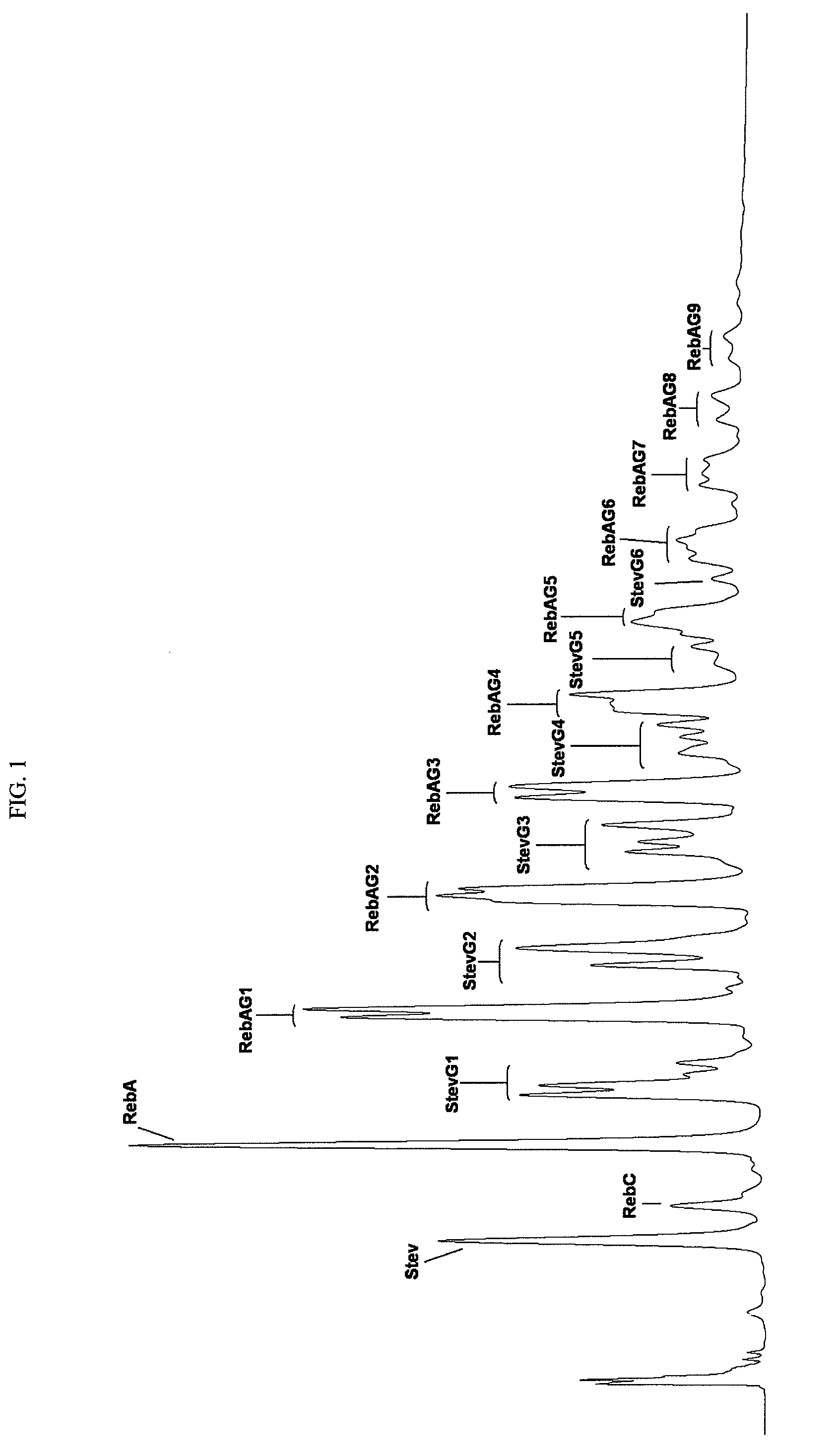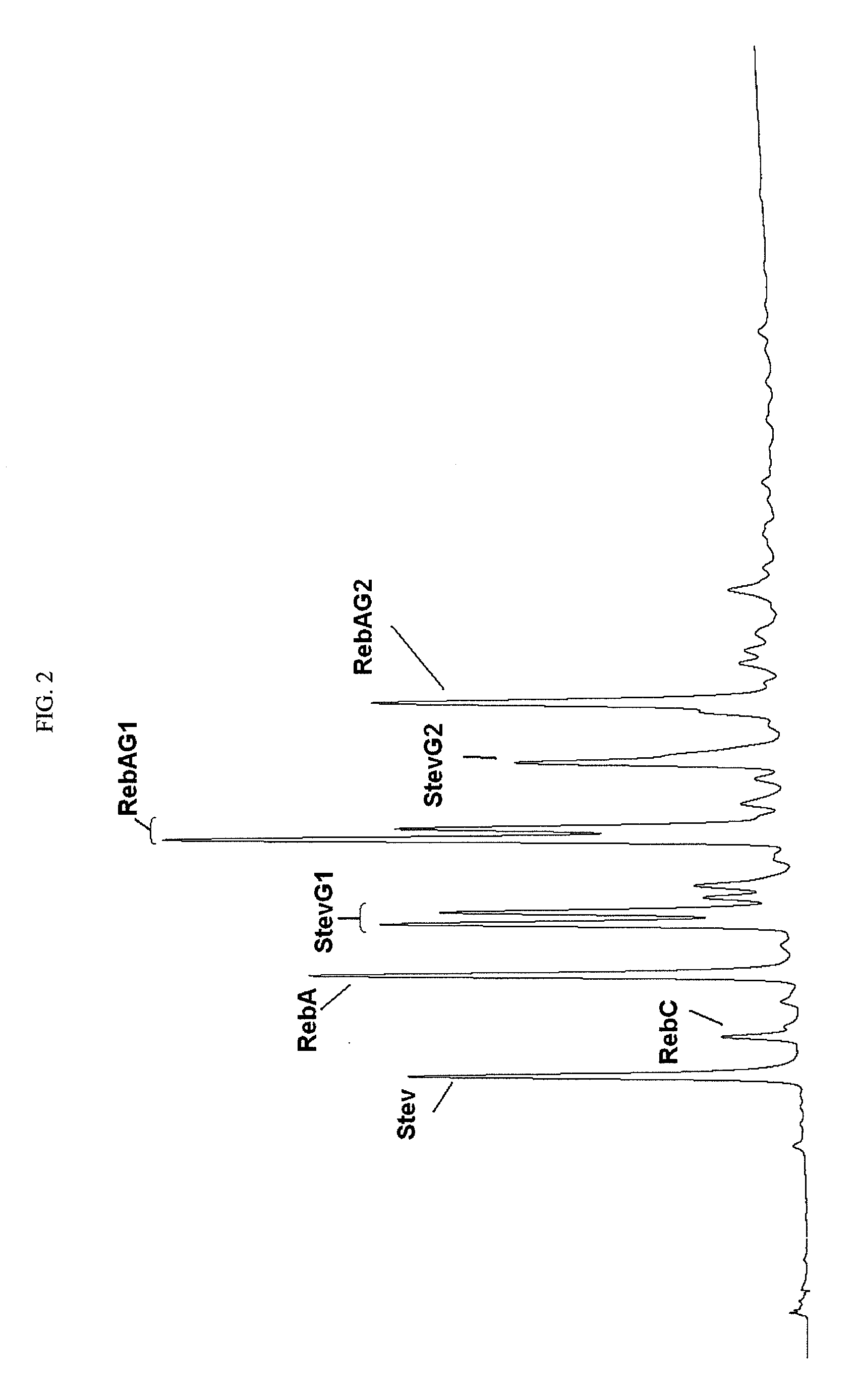Glucosyl Stevia Composition
- Summary
- Abstract
- Description
- Claims
- Application Information
AI Technical Summary
Benefits of technology
Problems solved by technology
Method used
Image
Examples
example 1
Preparation of CGTase
[0068]A strain of Bacillus stearothermophilus St-100 was inoculated in 2,000 liters of sterilized culture medium containing 1.0% starch, 0.25% corn extract, 0.5% (NH4)2SO4, and 0.2% CaCO3 (pH 7.0-7.5) at 56° C. for 24 hrs with continuous aeration (2,000 L / min) and agitation (150 rpm). The obtained culture broth was filtered using Kerasep 0.1 μm ceramic membrane (Novasep, France) to separate the cells. The cell-free permeate was further concentrated 2-fold on Persep 10 kDa ultrafilters (Orelis, France). The activity of the enzyme was determined according to Hale, Rawlins (1951). A crude enzyme preparation with activity of about 2 unit / mL was obtained.
example 2
Preparation of β-Amylase
[0069]A strain of Bacillus polymyxa St-3504 was inoculated in 2,000 liters of sterilized culture medium containing 1.0% starch, 0.5% peptone, 0.5% corn extract, 0.5% NaCl, 0.02% MnSO4 and 0.1% CaCO3 (pH 7.0-7.5) at 32° C. for 24 hrs with continuous aeration (2,000 L / min) and agitation (150 rpm). The obtained culture broth was filtered using Kerasep 0.1 μm ceramic membrane (Novasep, France) to separate the cells. 10% of glucose was added to the cell-free permeate which was further concentrated on Persep 10 kDa ultrafilters (Orelis, France) and dried using Alpha 1-4 LSC freeze drier unit (Christ, Germany) to obtain a powder with 20,000 AUN / g activity. β-Amylase activity unit (1 AUN) was defined as the activity which liberates 100 μg of reducing sugar (expressed by dextrose equivalent) per minute under the following conditions: 1 mL of enzyme solution is mixed with 5 mL of 1.2% starch solution (pH 5.5, M / 20 Acetate Buffer) and kept for 20 min at 40° C.
example 3
Preparation of Short-Chain Glucosyl Stevia Composition
[0070]100 g of tapioca starch was suspended in 300 mL of water (pH 6.5). 2 KNU of α-amylase (Termamyl Classic, Novozymes, Denmark) and 30 units of CGTase obtained according to EXAMPLE 1 were added, and the liquefaction of starch was carried out at 80° C. for about one hour to dextrose equivalent about 15. The pH of reaction mixture was adjusted to pH 2.8 by hydrochloric acid and the mixture was boiled at 100° C. during 5 minutes to inactivate the enzymes. After cooling to 65° C., the pH was adjusted to pH 6.0 with sodium hydroxide solution. 100 g stevia extract produced by PureCircle (JiangXi) Co., Ltd. (China), containing stevioside 29.2%, Rebaudioside A 54.3%, Rebaudioside C 9.0%, Rebaudioside F (1.7%) and other glycosides amounting to total steviol glycosides content of about 96.4% was added to liquefied starch and stirred until a homogeneous solution was obtained. 200 units of CGTase was added to the solution and the mixture ...
PUM
| Property | Measurement | Unit |
|---|---|---|
| Temperature | aaaaa | aaaaa |
| Temperature | aaaaa | aaaaa |
| Temperature | aaaaa | aaaaa |
Abstract
Description
Claims
Application Information
 Login to View More
Login to View More - R&D
- Intellectual Property
- Life Sciences
- Materials
- Tech Scout
- Unparalleled Data Quality
- Higher Quality Content
- 60% Fewer Hallucinations
Browse by: Latest US Patents, China's latest patents, Technical Efficacy Thesaurus, Application Domain, Technology Topic, Popular Technical Reports.
© 2025 PatSnap. All rights reserved.Legal|Privacy policy|Modern Slavery Act Transparency Statement|Sitemap|About US| Contact US: help@patsnap.com



